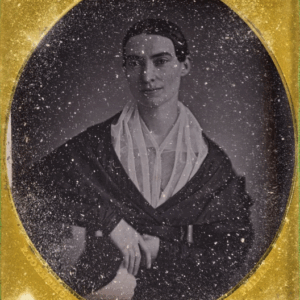JTF (just the facts): A total of 24 black-and-white photographs, framed in black and matted, and hung against white walls in a series of small connected gallery spaces. All of the works are gelatin silver prints, made between 1933 and 1962, in a mix of vintage and later prints. Physical sizes range from roughly 5×4 to 10×8 inches (or the reverse), and no edition information was provided. (Installation shots below.)
Comments/Context: Like many artists who have wandered from place to place, working in different locations, it’s a bit tricky to geographically categorize just exactly where Kati Horna should fit. Born in Budapest, her early artistic years found her bouncing from Berlin, to Paris, and on to Barcelona (during the Spanish Civil War), and ultimately to Mexico, where she settled in 1939 when World War II broke out. Like the Italian photographer Tina Modotti, Horna is often labeled a Mexican photographer, although her stylistic roots clearly draw on European Surrealism.
This succinct gallery show survey of Horna’s work builds on a 2016 exhibit at the America’s Society (reviewed here) and the sporadic inclusion of her prints in various New York group shows and art fairs since then, providing a tidy sampler of some of her most notable images and projects. A small group of pre-Mexico images from the 1930s provides a few introductory examples of Horna’s interest in surreal found subjects, with dolls, headless mannequins, and grinning waiter figures discovered at the Marché aux Puces in Paris seen with an edge of strange unease. This unsettled mood is amplified in a 1938 photomontage Horna made in Barcelona, where a woman’s face is laid atop an image of the cathedral steps, with her cheek cracking into bricks and her eye aligned with a barred window, capturing the rising undercurrent of public fear in that moment.
After Horna moved to Mexico, she settled into a vibrant community of expatriate artists, where she developed a long-standing friendship with the British surrealist painter Leonora Carrington. In the late 1950s and early 1960s, Carrington was a repeated model/subject for Horna, and several examples of their collaboration have been included in this show. Some capture Carrington at work as an artist, either intently painting or more improvisationally arranging a horned mask and a jumble of doll heads into charged installations. In other works, Horna returns to surreal photomontage, staging a tiny Carrington near a much larger bushy potted plant or superimposing Carrington’s head on top of a Renaissance portrait.
The early 1960s were a particularly fertile creative period for Horna, with several memorable projects coming in a relative burst of activity. Her 1962 series “A Night at the Doll Hospital” expands from the usual idea of a surreal doll found here or there into dense gatherings of dolls, doll heads, and various plastic body parts, many of the images functioning like busy crowd scenes. Doll heads are stacked in rows and overseen by a nurse doll, some dolls cradle even smaller dolls like their own offspring, and one crowd of naked dolls features Jesus and Mary unexpectedly mixed in. Other works take a more formal abstract approach, separating arms, legs, and heads into re-arrangeable compositional parts, which Horna then doubles and superimposes in a manner reminiscent of Frederick Sommer’s precise still lifes. Hung together in one intimate room, these doll images are engagingly eerie, each blank-eyed face and leftover limb piled up with inanimate freakishness.
Another 1962 series “Ode to Necrophilia” takes a more mournful tone, wrestling with the intermingled emotions of sorrow and desire. The three staged images from the larger series on view here feature an empty single bed, with a white death mask placed on the pillow; a nude woman with a lit candle engages with symbolic death in various poses, from quietly waiting and watching, to more openly engaging the mask (as though in conversation), to bent over in emotional despair or suffering. These stylized images have a sense of ritualistic grief mixed with inward-looking melancholy and heartache, where sadness and unresolved attraction are powerfully (and mysteriously) connected.
Three additional photographs from 1962 find Horna getting even more experimental. In one, the Mexican actress Luz del Amo poses behind a large glass bottle, leading to a shimmering distorted portrait; in a second, a different Mexican actress (Beatriz Sheridan) puts her face near a circular mirror, creating a doubled/split persona effect; and in the third, isolated single eyes hover in enveloping whiteness, slowly disappearing as they drift downwards. In each case, Horna has brought a touch of the avant-garde to the female face, re-imagining it in alternate forms and with different emotional resonances.
As a recent exhibition Surrealism Beyond Borders exhibit at the Met explored (here, which did not include Horna), the diaspora of Surrealism spread around the globe in unpredictable ways, adapting itself to local conditions on various continents across several decades. Horna’s photographs would have fit neatly into the thesis of that show, as they merge the original seeds of European Surrealism with uniquely Mexican subjects and traditions, and then pass the resulting ideas through the prism of Horna’s own vision. While this small show doesn’t necessarily bring new scholarship to Horna’s under-known story, it is certainly a smart gathering of some of her most durably important works; in just a few rooms, it provides a tightly-edited introduction to a photographic name that deserves better recognition.
Collector’s POV: The prints in this show range in price from $4500 to $17000. In the past decade, few examples of Horna’s work have appeared in the secondary markets, so gallery retail likely remains the best option for those collectors interested in following up.














